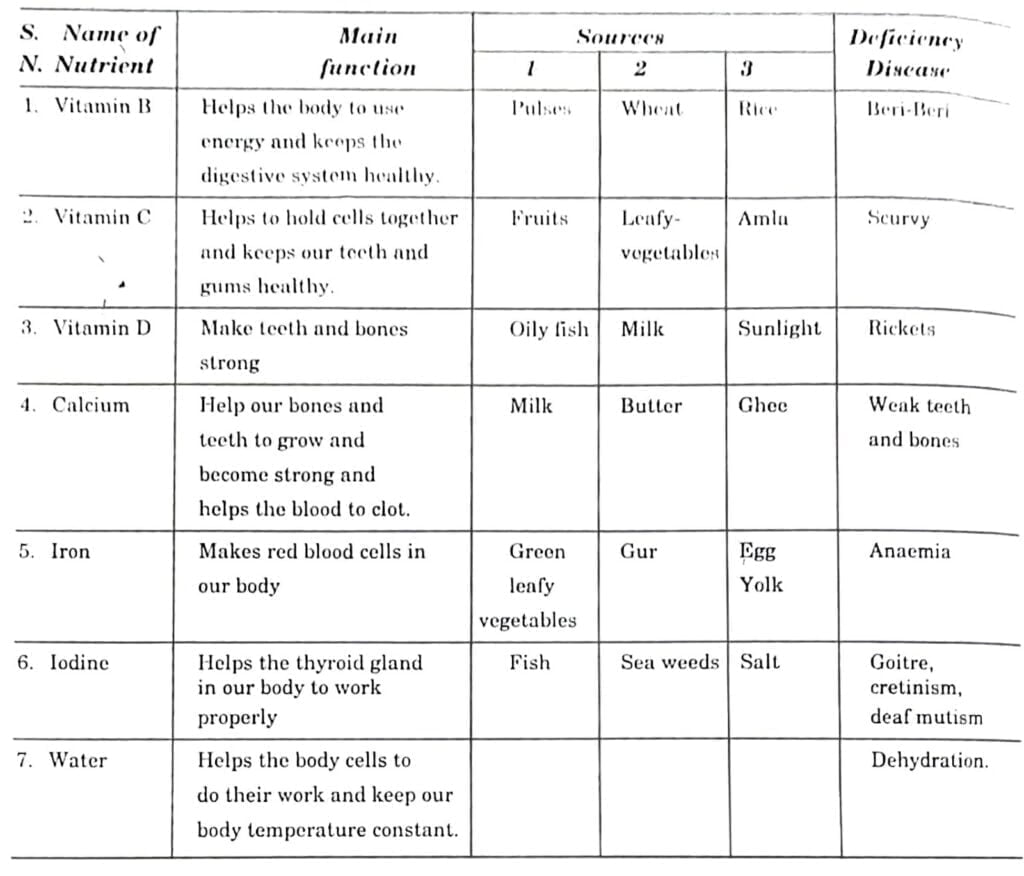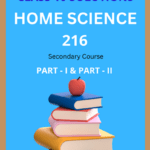NIOS Class 10 Home Science Chapter 2 Food And It’s Nutrients Solutions to each chapter is provided in the list so that you can easily browse through different chapters NIOS Class 10 Home Science Chapter 2 Food And It’s Nutrients and select need one. NIOS Class 10 Home Science Chapter 2 Food And It’s Nutrients Question Answers Download PDF. NIOS Study Material of Class 10 Home Science Notes Paper 216.
NIOS Class 10 Home Science Chapter 2 Food And It’s Nutrients
Also, you can read the NIOS book online in these sections Solutions by Expert Teachers as per National Institute of Open Schooling (NIOS) Book guidelines. These solutions are part of NIOS All Subject Solutions. Here we have given NIOS Class 10 Home Science Chapter 2 Food And It’s Nutrients, NIOS Secondary Course Home Science Solutions for All Chapters, You can practice these here.
Food And It’s Nutrients
Chapter: 2
[Book – I] HOME SCIENCE
Textual Question With Answers
Intext Questions 2.1.
Q.1. State four reasons for eating food.
Ans: (a) Food gives strength to fight against diseases.
(b) Food gives us energy to work.
(c) Food helps the body to function normally.
Q.2. Choose the correct alternative given below at the end of each statement:
| (i) The main use of proteins in the body is | (a) Energy for work and play |
| (ii) Besides energy fat helps in | (b) Growth and repair of tissues |
| (iii) Carbohydrates are needed to provide | (c) Making food testy |
| (d) Protection to delicate organs in the body |
Ans:
| (i) The main use of proteins in the body is | (b) Growth and repair of tissues |
| (ii) Besides energy fat helps in | (c) Making food testy |
| (iii) Carbohydrates are needed to provide | (a) Energy for work and play |
Q.3. Name the main nutrient present in following:

Ans: (a) Fat, (b) Fat, (c) Fat, (d) Protein, (e) Protein, (f) Protein, (g) Protein, Fat, (h) Carbohydrates, (i) Carbohydrates, (j) Protein, (k) Carbohydrates, (l) Fat.
Q.4. Find out the answers for following questions from the puzzles below. You may look horizontally or vertically. Write your answer in the provided.

(a) Which nutrient provides maximum amount of energy __________.
Ans: Fat.
(b) Nutrient found in eggs in abundance __________.
Ans: Protein.
(c) Major source of energy in our daily diet ____________.
Ans: Cereal.
(d) Good source of carbohydrate ___________.
Ans: Potato.
INTEXT QUESTIONS 2.2.
Choose the correct option to complete the statement given below:
Q.1. (a) Calcium is needed for:
(i) Improving the taste of food.
(ii) Healthy bones.
(iii) Strong teeth.
(iv) Clotting of blood.
Ans: (iii) Strong teeth.
(b) Richest source of iron is:
(i) Iodized salt.
(ii) Milk.
(iii) Leafy vegetables.
(iv) Wheat.
Ans: (iii) Leafy vegetables.
(c) Fortified salt is rich in:
(i) Iron.
(ii) Iodine.
(iii) Calcium.
(iv) all the above.
Ans: Iodine.
(d) Person suffering from iodine deficiency must eat/ drink:
(i) Sea food.
(ii) Root and tubers.
(iii) Milk Products.
(iv) Fibre rich food.
Ans: (i) Sea food.
(e) Movement of muscles definitely requires presence of:
(i) Iodine.
(ii) Iron.
(iii) Calcium.
(iv) all the above.
Ans: (iii) Calcium.
Q.2. Tick mark (✓) the fat soluble vitamins from the choices given:
(a) Vitamin A.
(b) Vitamin B.
(c) Vitamin C.
(d) Vitamin D.
Ans: Vitamin A and Vitamin D.
Q.3. Which vitamin will you get from the following food items?
(i) Amla _______.
Ans: Vitamin C.
(ii) Carrot ______.
Ans: Vitamin A.
(iii) cereals ______.
Ans: Vitamin B.
(iv) eggs _____.
Ans: Vitamin A and Vitamin B.
(v) fish oil______.
Ans: Vitamin A and Vitamin D.
(vi) Green leafy vegetables _______.
Ans: Vitamin A and Vitamin B.
(vii) Sprouted pulses_______.
Ans: Vitamin C.
(viii) Sunlight on skil ______.
Ans: Vitamin D.
(ix) Milk________.
Ans: Vitamin A.
(x) Butter _______.
Ans: Vitamin A and Vitamin D.
(xi) Pumpkin _______.
Ans: Vitamin A.
(xii) liver_______.
Ans: Vitamin A.
Q.4. Fill in the blanks:
(i) Vitamin D can be produced by the __________ in the presence of __________.
Ans: Body, Sunlight.
(ii) One function of vitamin A is to keep our ___________ healthy.
Ans: Eyes.
(iii) To keep our gums and teeth healthy we must take __________.
Ans: Calcium.
(iv) The Vitamin which makes bones and teeth strong is___________.
Ans: Vitamin B.
INTEXT QUESTIONS 2.3
Q.1. State whether the following statements are true or false if true give the justification:
(i) True/ False: Fibre is not essential in the diet.
Ans: False. Make digestive system healthy.
(ii) True/ False: We must remove the outer skin of apples before eating.
Ans: False. Apple skin is rich in fibre.
(iii) True/ False: Fibre helps in the prevention of cancer.
Ans: True.
(iv) True/ False Fibre markes fat.
Ans: False. Makes you fit and healthy.
(v) True/ False Fibre is found in tomatoes and grapes.
Ans: True.
(vi) True/ False: Fibre increases bulk of the foot.
Ans: True.
(vii) True/ False: You will lose weight if you do not eat fibre.
Ans: False. Fabri gives a feeling of safety and prevents overeating.
Intext Questions 2.4.
I put a tick mark (✓) against the right answer.
Q.1. Deficiency diseases are those that occur in your body because of:
(i) Less water.
(ii) Absence of a nutrient.
(iii) Absence of exercise.
(iv) Presence of disease germs.
Ans: (ii) Absence of a nutrient.
Q.2. Vitamin A is important because it:
(i) Prevents night blindness.
(ii) Keep the skin healthy.
(iii) Prevents anaemia.
(iv) Prevents constipation.
Ans: (i) prevents night blindness.
Q.3. Haemoglobin formation is reduced in:
(i) Scurvy.
(ii) anaemia.
(iii) Goitre.
(iv) Night blindness.
Ans: (ii) anaemia.
Q.4. If you take excessive amount of carbohydrates, you will become:
(i) Underweight.
(ii) Anaemia.
(iii) Obese.
(iv) Marasmic.
Ans: (iii) Obese.
Q.5. An example of a food which prevents vitamin A deficiency is:
(i) Spinach.
(ii) lemon.
(iii) Banana.
(iv) Potato.
Ans: (i) Spinach.
TERMINAL EXERCISES
Q.1. Last the four important function of food.
Ans: Function of food:
1. Foods gives energy to do work.
2. Food helps in the growth and repair of tissues.
3. Food gives the strength of fight against disease germs.
4. Food helps in making the body function normally.
Q.2. Recommend three energy giving food for an active school going child.
Ans: Three energy giving food:
1. Vegetable poha, vegetable sandwiches.
2. Egg buns, palak cheela.
3. Palak Puri, with dry dal.
Q.3. Justify the need of extra calcium and iron in diet of adolescents.
Ans: Calcium: Calcium has vital significance in the diet of adolescents. It is required for various internal activities, growth of bones, strengthening of teeth and coping up with mental tensions, sufficient intake of calcium in diet fulfils the requirements of phosphorus an well.
Iodine: Sufficient amount of iodine in diet of adolescents is very essential and important for their physical and mental growth. Deficiency of iodine leads to goitre.
Q.4. Write name of any four deficiency diseases and mention one symptom of each.
Ans: Name of four deficiency diseases and it’s symptom:
1. Vitamin A → blindness → Initial deficiency symptoms of vitamin A are burning, itching dryness and inflammation of eyes followed by “nyclolopia” (night blindness).
2. Vitamin D→ Rickets→ Sweating and irritability are the early symptoms of rickets.
3. Vitamin B→Beri-Beri→Loss of appetite persistent vomitting and diarrhoea, sometimes the disease is accompanied with fever.
4. Vitamin C→Scurvy→Deficiency of vitamin C interferes with the absorption of iron and acid, consequently the resultant anaemia and feeling of fatigue.
Q.5. Match the nutrient given in column A with their functions in column B:
| Column A | Column B |
| 1.Vitamins and minerals 2. Proteins 3. Carbohydrates | (a) .Body building and repair of tissues (b) Energy giving (c) Protection from the diseases |
Ans:
| Column A | Column B |
| 1.Vitamins and minerals 2. Proteins 3. Carbohydrates | (c) Protection from the diseases (a) Body building and repair of tissues (b) Energy giving |
Q.6. Complete the table given below:
| S. No. | Name of nutrient | Main function | Sources1 2 | DeficiencyDisease |
| 1. | Vitamin B | |||
| 2. | Vitamin C | |||
| 3. | Vitamin D | |||
| 4. | Calcium | |||
| 5. | Iron | |||
| 6. | Iodine | |||
| 7. | Water |
Ans:

SOME OTHER IMPORTANT QUESTIONS FOR EXAMINATION
Multiple Choice Questions
Choice the correct answer and tick mark (✔):
1. One gram of protein gives:
(a) 4 Kcal
(b) 5 Kcal
(c) 9.3 Kcal
(d) 10 Kcal
Ans: (a) 4 Kcal.
Q.2. An adult person need _________ gms of carbohydrates everyday.
(a) 300-350
(b) 400-420
(c) 420-450
(d) 350-400
Ans: (b) 400-420
Q.3. Which of the following is not a fat soluble vitamin?
(a) Vitamin A
(b) Vitamin D
(c) Vitamin B
(d) Vitamin K
Ans: (c) Vitamin B
Q.4. One gram of fat gives us _________Kcal.
(a) 5
(b) 9
(c) 6
(d) 4
Ans: (b) 9
Q.5. Sea foods like fish and sea weeds are the sources of:
(a) Iodine
(b) Fats
(c) Calcium
(d) Vitamin E
Ans: (a) Iodine
Q.6. PEM deficiency mainly occurs in children below ______ years of age.
(a) 10
(b) 15
(c) 5
(d) 12
Ans: (c) 5
Q.7. Vitamin D prevents us from which disease?
(a) Night blindness
(b) Rickets
(c) Beri-Beri
(b) Scurvy
Ans: (b) Rickets
Q.8. Beri-Beri is caused when there is deficiency of:
(a) Vitamin C
(b) Vitamin B
(c) Vitamin A
(d) Vitamin D
Ans: (b) Vitamin B
Q.9. Which of the following are Nutrients?
(a) Protein
(b) Carbohydrates
(c) Fats
(d) All of the above
Ans: (d) All of the above

Hi! my Name is Parimal Roy. I have completed my Bachelor’s degree in Philosophy (B.A.) from Silapathar General College. Currently, I am working as an HR Manager at Dev Library. It is a website that provides study materials for students from Class 3 to 12, including SCERT and NCERT notes. It also offers resources for BA, B.Com, B.Sc, and Computer Science, along with postgraduate notes. Besides study materials, the website has novels, eBooks, health and finance articles, biographies, quotes, and more.




